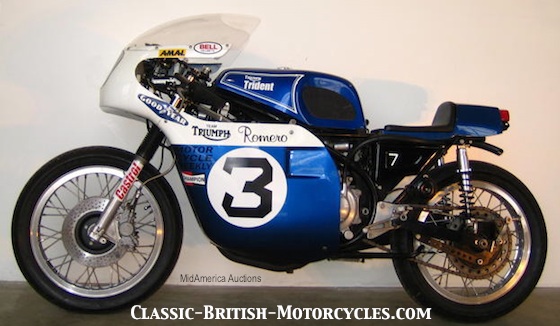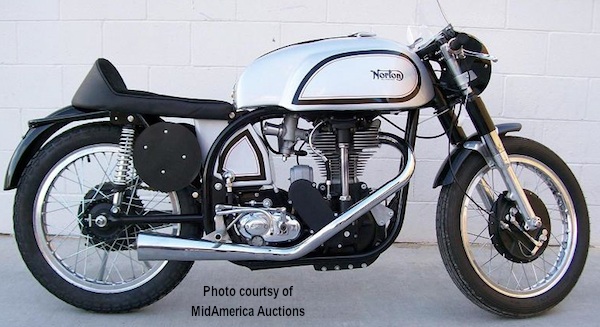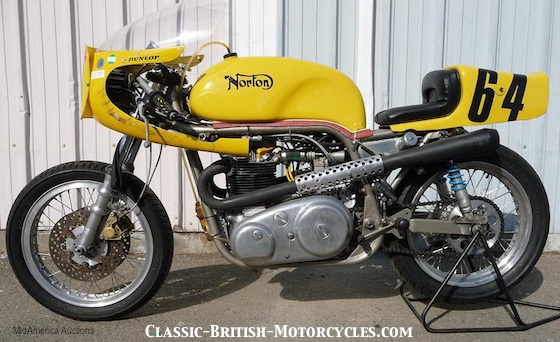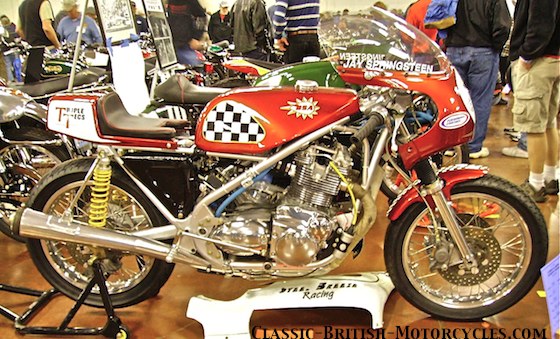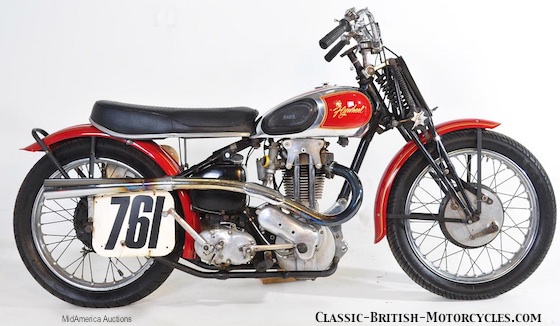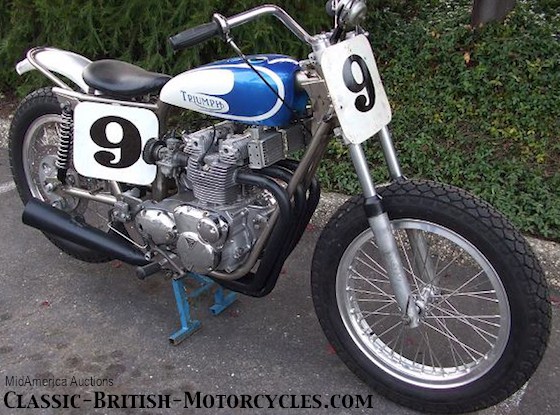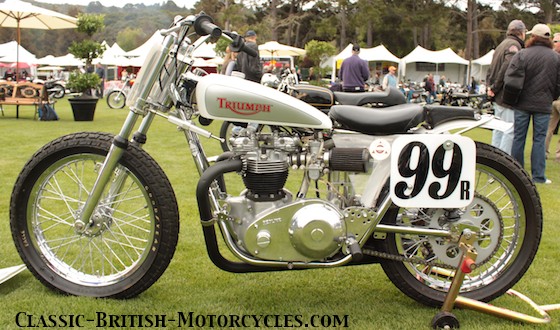CLASSIC BRITISH ROAD RACING MOTORCYCLES This 1969 Triumph Trident T150 Road Racer was campaigned by the legendary Gene Romero (above).
The development of motorcycle racing has largely dominated many racing sports over time. The sport involves road racing, off road racing, both either on circuits or open courses and track racing. There is now a Federation of International Motorcycling which is global governing body of motorcycle racing. It represents over 100 motorcycle federations that are divided into the different regional continents.
Motorcycle Grand Prix is the most popular and the Federation of International Motorcycling established the World Championship in 1949. In the past it was classed as the 500cc championship but changed in 2002 to create a MotoGP class which allowed machines of up to 500cc compete with machines of up to 900cc. MotoGP has a rich history with the Grand Prix taking place in multiple places of the world, and it saw 2.4 million people through the gates.

DESERT RACERS, DIRT BIKES & MOTOCROSSERS –
This sweet 1963 BSA Rocket Gold Star is a classic desert racer (above).

FLAT TRACKERS, TT & SCRAMBLES BIKES
1968 Triumph T120 Bonneville Flat Track Racer (above).
CLASSIC BRITISH RACING MOTORCYCLES – PAVING THE WAY
From the earliest days of the Motorcycles’ history, British motorcycles were at the forefront of racing design & technology. The Isle of Man TT (Tourist Trophy), off the coast of England, was one of the first true road races & became the proving ground for motorcycle designers & engineers from all over the world. Early mechanical pioneers from England, Europe (mostly Germany & Italy) & America cut their teeth, honed their craft & perfected their designs on this tough road circuit. But the British all seemed to be in the lead, or at least up front, in the march toward higher performance & better handling.
The Isle of Man TT is one of the most dangerous motorcycle races in the world. Even though a San Diego personal injury attorney would advise against entering such a hazardous race, the best riders are willing to accept the risk to take part in the prestigious Isle of Man TT.
CLASSIC BRITISH RACING MOTORCYCLES – IT’S ALL ABOUT THE BIKES
In the end, Classic-British-Motorcycles.com is just that: a site dedicated to the appreciation of our favorite motorcycles. So, while its difficult to do, this page will focus on the racing motorcycles themselves, rather than the motorcycle races. This is not meant to be a history of British Motorcycle Racing. Although that may come soon. But for now…it’s all about the bikes. Enjoy.
Racing Motorcycles – Road Racers
ROAD RACING MOTORCYCLES – 1953 NORTON MANX
This 1953 Norton Manx Road Racer (above) represented the state-of-the-art of racing motorcycle technology in 1953. Note the arched frame tube aft of the carburetor, the trademark of the legendary “Featherbed Frame”. The Featherbed was so good, and so much better than anything else at the time, that it allowed the aging 500cc single to dominate road racing for a decade. It’s full double-cradle design (unusual at the time) gave it stiffness & its brilliant geometry gave it superior handling.
2017 Isle of Man Manx GP
Our man Larry Orlick travels to the Isle of Man and covers this legendary road race for CBM.

ABOVE: This is the actual Norton Manx that Norton factory rider Geoff Duke rode to victory, introducing the world to the Featherbed Frame.
CLASSIC BRITISH RACING MOTORCYCLES – PREWAR TO POSTWAR
As engine technology developed, racing engines led the way. Side Valve (SV) or flathead engines gave way to Overhead Valves (OHV), which were eclipsed by Overhead Cams (OHC), which were in turn trumped by Dual Overhead Cams (DOHC), years ahead of production motorcycles. This 1953 Norton Manx was as sophisticated & developed as any big single would be, with a Single Overhead Cam driven by a shaft & bevel gears. It was powerful & reliable, but by the mid 1950’s, even this might brute was being eclipsed by the big multi’s (twins & fours). But Norton had another trick up its sleeve: The Featherbed Frame. This frame (pictured above) raised handling performance to an entirely new level, instantly making every other motorcycle racing frame obsolete. The Featherbed Frame extended the life of the big Norton single by at least a decade, proving the value of handling, even over outright horsepower.
CLASSIC BRITISH RACING MOTORCYCLES – THE MOTORCYCLE GROWS UP
Motorcycles left their bicycle roots in the 1910s & 20s & shed their pedals at the same time. By the 1930s, engines were growing in capacity & power output & frames were getting heavier & stronger in hopes of coping with the increasing performance. Just when things were really heating up in the last 1930s, World War II started & put a halt to all civilian motorcycle production for the next several years. From about 1940 to about 1945 all motorcycle production was devoted to military bikes & war materials. But once hostilities ended & civilian production struggled to get going again, racing resumed, in earnest, in 1946 & all the engineering know-how that had been gleaned during the war poured into motorcycle & automobile design, starting with the racing machines first, then trickling down over many years to production vehicles.
CLASSIC BRITISH RACING MOTORCYCLES – 1953 BSA GOLD STAR
BSA’s take on the same formula, a 1953 BSA Gold Star Clubman road racer (above).align=center>
CLASSIC BRITISH RACING MOTORCYCLES – 1950 AJS 7R ‘BOY RACER’
This lucious 1950 AJS 7R 350cc ‘Boy Racer’ Road Racer recently sold for $33,000 at the Mecum Auction at Pebble Beach, August 2011.
ROAD RACING MOTORCYCLES – 1956 MATCHLESS G45
AMC (Associated Motor Cycles) were well ensconced in racing well into the 1950s. This gorgeous 1956 Matchless G45 sold for $40,000 at the Mecum Auction in Pebble Beach in August 2011.
ROAD RACING MOTORCYCLES – 1957 BSA GOLD STAR FACTORY RACER
This 1957 BSA Gold Star factory road racer shows the advances that were being made in aerodynamics.
ROAD RACING MOTORCYCLES – 1960 BSA BANTAM FACTORY RACER
By about 1960, racing motorcycles took on a decidedly more modern look. This 1960 BSA Bantam 250 factory racer is a good example. This wonderful machine recently sold at the Mecum Auction at Pebble Beach in August 2011 for just $5,000.
ROAD RACING MOTORCYCLES – 1060 MATCHLESS G50
This handsome 1960 Matchless G50 Road Racer sold at the Pebble Beach Mecum Auction for $43,000.
ROAD RACING MOTORCYCLES – 1960 NORTON FACTORY RACER
This 1960 Norton factory road racer looks very similar to Norton’s Production Racers of the early to mid-1970s.
ROAD RACING MOTORCYCLES – 1969 TRIUMPH TRIDENT
Overshadowed in the marketplace by the game-changing Honda 750 Four, the Triumph Trident nonetheless proved to be a formidable racing machine propelling Gene Romero, among others to victory & glory. And the sound, a wail really, that the triples make on full boil is like nothing else on earth.
ROAD RACING MOTORCYCLES – BSA ROCKET 3 FACTORY RACER
Of course, BSA also had to have a 3-cylinder factory road racer, but of course theirs was based on their own Rocket 3.
RACING MOTORCYCLES – Desert Racers, Dirt Bikes & Motocrossers
RACING MOTORCYCLES – THE BRITS LEAD THE WAY IN THE DIRT, TOO
Immediately after World War II, as civilian production ramped up & the British economy got going again, the popularity of motorsports, racing of all kinds, was exploding. Auto races captured much of the limelight, but motorcycle racing was enjoying a boom in growth in all directions. While Road Racing had always been popular in Europe & England, it was fairly expensive for the ‘Average Joe’ & so many young men returning from the War turned to dirt bikes, in one form or another. They were fun, cheap, often nothing more than their commuter bike with the lights removed, and they could be ridden anywhere, out in the boonies. Off-road racing events of all kinds began springing up all over Europe & England and the British motorcycle industry was not long to catch on.
RACING MOTORCYCLES – PRE-WAR DESIGNS REHASHED
Most of the motorcycles being built immediately after the war, once civilian production resumed, were 1930s prewar designs, some dating back to the 1920s. Most were air-cooled, four-stroke, OHV (Overhead Valve) single-cylinders, displacing around 350cc to 500cc, with long strokes (undersquare) & gobs of torque at low rpms. These were quickly reworked as Britain’s motorcycle manufacturers rushed to retool for peacetime. In 1946, BSA reintroduced its class-leading Gold Star, and more or less set the standard for the breed. In fact, at the first International Six Day Trials (ISDT), held in England in 1949, it was a BSA Gold Star that won. Ariel, Matchless & AJS soon followed. But the 1950s belonged to the BSA Gold Star, and not just among Classic British Motorcycles. The BSA Gold Star was world-class & world-beating, right up until its demise in 1963, both off-road on the road racing circuits. By this time, big 4-stroke singles were falling out of vogue. First 4-stroke twins took over, led by the Triumph TT Specials and the TR6. But even they could not withstand the onslaught of lightweight 2-stroke singles, mostly from Japan. And that was the end of the game for most Classic British Off-Road Motorcycles, as competitive racing motorcycles, in all but open-class Scrambles, Vintage & old-timer Races.
OFF-ROAD RACING MOTORCYCLES – 1948 ARIEL RED HUNTER 500cc SINGLE
This 1948 Ariel Red Hunter represents Ariel’s take on the classic layout: long-stroke, 500cc single with pushrods actuating rocker arms in a hemispherical combustion chamber. Like so many early postwar machines, this ‘dirt bike’ was really little more than a stripped down road machine. Check out the rigid frame & girder front forks. Can you imagine taking a jump on this thing?
OFF-ROAD RACING MOTORCYCLES – 1955 AJS MODEL 18 500cc SINGLE
This 1955 AJS Model 18 500cc single is one more example of how British motorcycle design followed (or copied) tight patterns. Just like the Triumph Speed Twin set the pattern for vertical twin development that nearly every other British marque copied closely, the BSA Gold Star set a pattern for single-cylinder design that was copied by nearly everyone in the game. AMC (Associated Motor Cycles), always with the ‘badge-engineering’, spun their own ‘Gold Star-clone’ into two versions, one for each of their largest marques: the Matchless G80, and the AJS Model 18 (shown above, in off-road guise), both 500cc OHV singles.
0FF-ROAD RACING MOTORCYCLES – 1962 BSA GOLD STAR CATALINA SCRAMBLER
This is it, The Original, The Legend, the BSA Gold Star. This 1962 BSA Gold Star Catalina Scrambler represents the very pinnacle of BSA Gold Star development. The name commemorates BSA’s victory at the Catalina Gran Prix in 1958. 1963 was the very last year of production for the Gold Star. It was the end of an age. But the remnants still remain, to this day. Bikes like the new Royal Enfield 500 Bullet & the more modern “thumpers” from Japan & Europe were clearly inspired by the awesome & evergreen BSA Gold Star.
0FF-ROAD RACING MOTORCYCLES – 1963 BSA ROCKET GOLD STAR
This Rocket Gold Star was the last of the Pre-Unit BSA’s & an interesting amalgam of bike parts. BSA took a twin-cylinder 650cc engine out of the pre-unit A10 Rocket & shoe-horned it into a modified Gold Star (single cylinder) frame. It was a hybrid between the “Rocket” 650 engine & the “Gold Star” frame, hence the name. And it performed brilliantly…for one year, and one year only. By 1963, BSA and Triumph had converted over to Unit Construction engines & all new frames, thereby ending the supply of the pre-unit A10 engine. And of course 1963 was the swan song of the Gold Star, curtailing the supply of frames. Kind of makes you wonder why BSA went to all the trouble? But I, for one, am glad they did. These are gorgeous machines are now much sought-after by collectors.
OFF-ROAD RACING MOTORCYCLES – 1965 TRIUMPH BONNEVILLE TT SPECIAL
While the stalwart old 500 singles seemed to suit the British & European off-road markets, by the late 1950’s the American market, and consequently US Dealers began demanding more. More speed, more power, more cylinders. The desert-racing craze was gaining momentum in the Western States & Triumph was quick to respond with the TR6 Trophy in 1956 & things just heated up from there. By 1959, it sprouted a second carburetor & the Bonneville was born. Within a few years, there was a factory-built off-road version, the T120C, with high pipes & quickly-detachable headlights. But, nearly anything could be ordered as an option, including hotter cams, higher compression & different gearing. By 1965, the Meriden factory pulled it all together into a new sub-model in the Bonneville line, the TT Special, with 11:1 compression, racing cams & the coolest pipes on the planet, the popular “TT Pipes”. TT Specials like this 1965 model, typified what became known as “desert sleds” & dominated desert racing for years.

…THEN, ALONG CAME THE RICKMAN BROTHERS
OFF-ROAD RACING MOTORCYCLES – 1970 RICKMAN METISSE – BSA 441
As Britain’s age-old classic engine designs became increasingly obsolete, in the face of withering competition from abroad, the scrappy Brits did what they always do: they got creative. When the aging Manx could no longer compete, Norton didn’t design a costly new engine, they built a radical new frame: the legendary Featherbed. And it allowed the Norton Manx to dominate road racing for another 10 years, over much more modern & powerful machines. British racecar building Lotus has always approached performance by reducing weight, not adding expensive horsepower. And the Rickman Brothers, legendary British frame makers (and several other British firms), did it again by building lightweight racing frames for several mainstream British motorcycle engines. This 1970 Rickman Metisse is built around a BSA 441 Victor engine & offered excellent & exceptional handling for its day. It made the lumpy BSA single far more competitive than it was in the stock bike, and it just plain looked gorgeous! With that nickel-plated frame & those elegant polished conical hubs, they just looked expensive, and they were. In the early 1970’s, if you showed up with a Rickman in the back of your truck, you were just plain IT!
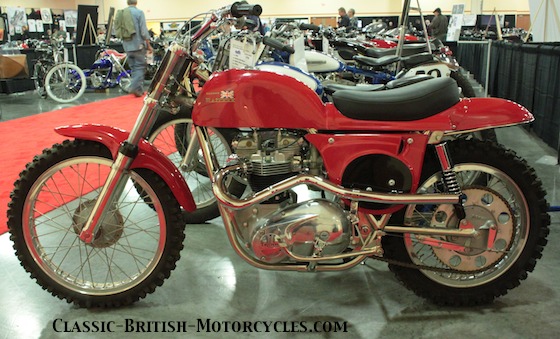
OFF-ROAD RACING MOTORCYCLES – 1970 RICKMAN METISSE – TRIUMPH 650
Another sweet Rickman. This one with a Triumph 650 twin engine, and on a Rickman, always a single-carb motor from a Triumph TR6. Because of the configuration of the Rickman’s frame, the splayed dual carbs of the Bonneville won’t fit.
RACING MOTORCYCLES – Flat Trackers, TTs & Scramblers
RACING MOTORCYCLES – BIG BRITISH TWINS MAKE GREAT FLAT TRACKERS
…SINGLES & TRIPLES DO TOO
What’s the first thing you think of when someone says ‘Flat Tracker’? A big British twin, right? Probably a Triumph. There is something about the torque characteristics of a 360-degree parallel twin that just works on a dirt track. And there is something about the sound they make too. But, as we’re about to see, Flat Trackers can come in a variety of cylinder-counts.

FLAT TRACK RACING MOTORCYCLES – 1956 BSA B33 FLAT TRACKER
Back in the 1950s, most Flat Trackers were British singles. This BSA single is a prime example.

FLAT TRACK RACING MOTORCYCLES – “PITTY TINK”
The original “Pitty Tink” was built by Jim Anderson & Arnold Jean in 1957. Anderson raced it through 1957-58 throughout Arizona, ultimately winning the 1958 Arizona State Flat Track Championship. It was later ridden by National #41 Pat McHenry in the 1958 AMA National TT Races in Peoria IL, but didn’t place. For some reason, the look of the bike really caught on & it has got to be one of the most ‘cloned’ bikes on the planet. Other than all the Triumph TR6’s running around with twin carb heads calling themselves ‘Bonnevilles’, of which I myself am guilty (although I always told the truth in the end). This “Pitty Tink” ‘tribute’, or ‘replica’, or ‘clone’ is based on a 1956 Triumph Tiger T110. It really epitomizes flat track motorcycle technology at that time, much of which survives to this day. This is one awesome looking racing motorcycle, certainly worth of all the attention.
FLAT TRACK RACING MOTORCYCLES – A TRIDENT?
Now here’s something you don’t see everyday. A Triumph Tident flat tracker. The big 750 triple engines were considered to be too wide & too heavy for flat track racing. And the power delivery of the vertical twins was believed to be superior to the smoother triples. But, someone built this Trident Flat Tracker anyway, with a Trackmaster Frame, and if it goes anywhere nearly as good as it looks, then it should be a winner!
FLAT TRACK RACING MOTORCYCLES – THE MODERN FLAT TRACKER
Here is the modern take on a Classic British Flat Track Racing Motorcycles. All the latest & best equipment, from the chromed Trackmaster racing frame to the Ceriani-style from forks, to the Sudco Mikuni carbs, to the slimline primary cover. And I’m sure it’s as fast as it looks. The only problem with a bike like this is that I’d never want to get it dirty!
Have fun out there, but be safe. Racing is serious business, especially on a motorcycle. Always be smart about it, and wear proper safety gear, beginning with a good helmet. Enjoy the ride…


